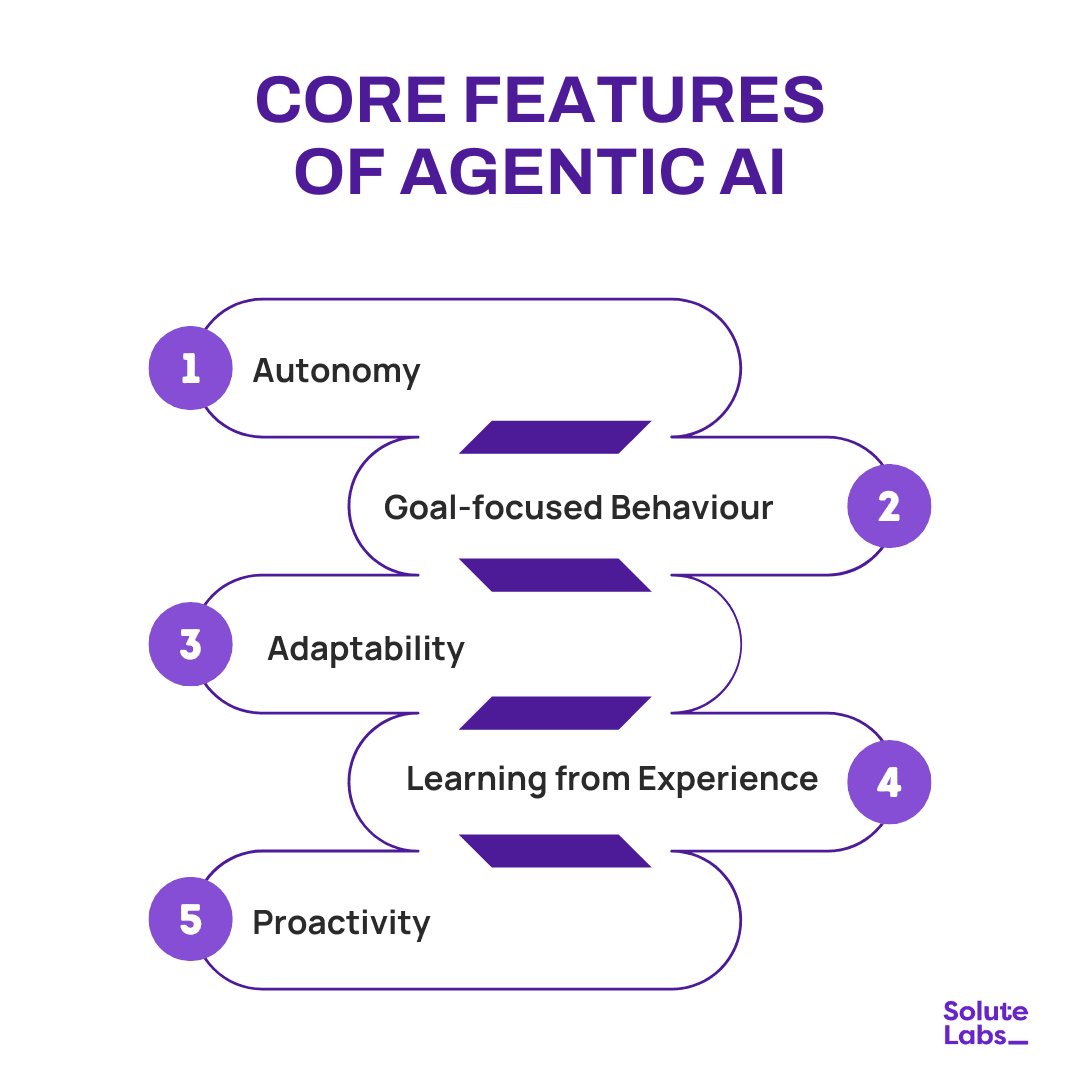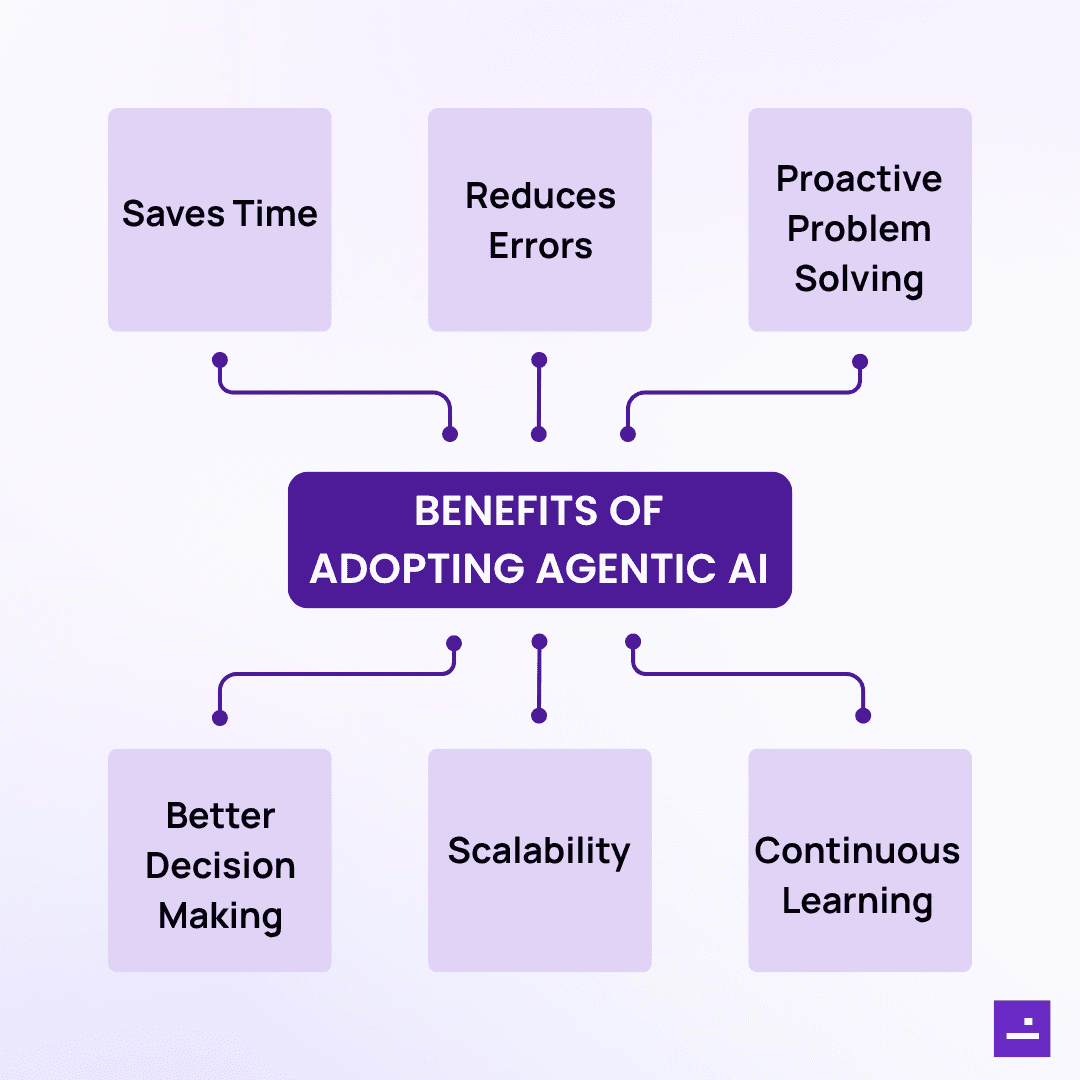AI is no longer a futuristic buzzword. It’s in our phones, cars, shopping apps, pretty much everywhere. But the type of AI most people know is still reactive. You ask, it answers. You give input, it gives output. That’s useful, but it’s also limited.
Now imagine an AI that doesn’t just sit and wait but can notice, plan, and act on its own. That’s the idea behind agentic AI. Instead of being a passive tool, it behaves more like a problem-solver that can figure out what needs to be done.
And interest is rising quickly. The global AI market is expected to jump from $214 billion in 2024 to $1,339 billion by 2030 (MarketsandMarkets). A big part of that growth will come from smarter, more autonomous systems.
In this guide, we’ll unpack what agentic AI really means, how it works, where it’s being used, and how it stacks up against traditional AI.
Understanding Agentic AI
So, let’s clear this up, what is agentic AI? People sometimes make it sound more complicated than it is. At its core, it’s just AI that can actually do things on its own instead of waiting for us to tell it what to do.
Most of the AI we’ve gotten used to is reactive. You type a question, it answers. You upload data, it gives you results. That’s fine, but it’s like having a tool that never moves until you pick it up.
Agentic AI flips that idea. It works more like a teammate who notices something and just handles it. It doesn’t sit idle waiting for instructions. Instead, it senses what’s happening around it, figures out the next step, and then takes action.
Here’s an easy way to picture it:
- A regular AI chatbot: answers only if a customer types a message.
- An agentic AI chatbot: sees a customer stuck at checkout and jumps in to guide them, without being asked.
That difference might sound small at first, but it’s massive in practice. Moving from reactive to proactive means AI isn’t just a tool anymore; it starts acting like a decision-maker. And that’s why people are saying it’s the next big step in how we use artificial intelligence.
How Agentic AI Works?
To visualize agentic AI as a self-directing problem solver is the simplest method to grasp its operation. This thing is constantly in a state of monitoring, thinking, and doing; it doesn't sit about doing nothing until you press the "run" button. The agent cycle, which essentially consists of the following steps:
1. Viewing (Stage of Perception)
Data intake is the first step for the system. This might be anything from data collected from sensors in a manufacturing machine to actions taken within various apps or even customer behavior on a website. Collecting isn't the only goal; comprehending the scenario is as important.
2. Evaluating (Deciding)
The AI determines the optimal course of action once it has sufficient information. Will it intervene? Can it hold off? Does it make the situation worse? It isn't merely reacting; it is considering alternatives, which is how it differs from basic AI.
3. Action
It then goes on and does the deed. This could involve suggesting a user's next best move, sending a reminder email, or resolving a process mistake that keeps happening.
4. Reflection and Learning
The strength of agentic AI lies in the fact that it continues to function even after the action has ended. It evaluates the result, whether it was successful or not, and adjusts its approach for the subsequent round.
To sum up, it's not a one-and-done deal. The process is an ongoing loop of perceiving → thinking → acting → improving. People claim it's more in line with how humans solve problems because of it.
Core Features of Agentic AI

Agentic AI isn’t just “smart.” It’s kind of like giving a kid a bike for the first time and watching them figure out how to ride on their own. Sometimes they wobble, sometimes they crash, but most of the time, they get it. That’s basically how agentic AI works. It has a few things going on that make it special:
- Autonomy: You don’t have to tell it every little thing. It notices problems and decides what to do. Sure, it can make weird choices sometimes, but that’s part of the learning.
- Goal-focused Behaviour: It’s not just wandering around. It knows what it’s trying to accomplish. Could be fixing a process, helping a user, or completing a task.
- Adaptability: Things don’t always go as planned. Agentic AI can switch strategies when something unexpected happens. It’s not perfect, but it tries.
- Learning From Experience: After acting, it looks at results. Did it work? Did it fail? Then it tweaks its approach for next time. Little trial and error, but faster than humans.
- Proactivity: And here’s the fun part: it doesn’t always wait for instructions. If it sees a chance to help or fix something, it just does it. Sometimes it surprises you. Sometimes you scratch your head. But it acts.
Real-World Applications of Agentic AI
Agentic AI isn’t just some theory anymore. It’s out there actually doing stuff. The thing is, the structure of the agent in AI makes it able to watch, decide, act, and learn all at once. Kind of like a coworker who actually pays attention and jumps in when needed.
Here’s some of the real world examples of agentic AI across several industries:
- E-commerce: You know those times when you’re stuck at checkout? Some AI agents use low code tools, just notice and jump in to help. Saves frustration, and sometimes even the sale.
- IT & Tech: Systems that keep an eye on servers or networks, fix tiny problems, and only bug humans when it’s serious. Makes life easier for IT teams.
- Healthcare: AI agents track patient stats, flag things that look off, and even suggest what doctors might check next. Pretty handy when there’s a lot going on.
- Finance: Spotting weird transactions before anyone notices. Prevents fraud, manages risks, all quietly in the background.
- Logistics & Supply Chain: Routes change, deliveries get delayed. AI agents notice early, reroute, or alert someone. Saves a lot of headaches.
- Manufacturing: Machines sometimes act up. AI can tell when maintenance is needed before the machine even stops working. Kind of like a preventive watchdog.
And here’s the kicker, when businesses are building an agentic AI system, it’s not just coding. You’re figuring out goals, how the agent sees and acts, and how it learns from results. The structure of agent in AI is basically the blueprint that makes all this possible.
So yeah, agentic AI isn’t just a buzzword. It’s quietly running stuff behind the scenes, fixing problems, helping humans, and learning as it goes. And honestly, that’s what makes it so exciting.
Benefits of Adopting Agentic AI

So, why bother with agentic AI at all? Well, the thing is, it doesn’t just do what you tell it, it actually helps you get stuff done on its own. And that can make a big difference in a bunch of ways. Here are some of the benefits of agentic AI:
1. Saves Time
Imagine a system that notices problems before they become big. You don’t have to babysit every process. It jumps in and handles stuff. Saves hours, sometimes days.
2. Reduces Errors
Humans slip up. Always. Agentic AI can spot small mistakes early and fix them. It’s not perfect, of course, but it catches a lot that would otherwise slip through.
3. Proactive Problem Solving
This is the cool part. It doesn’t just wait for something to go wrong. If it sees a chance to prevent an issue or improve a process, it acts. Kind of like a helpful teammate who’s always one step ahead.
4. Better Decision-Making
Because it observes and learns constantly, it can offer suggestions or even make small decisions on its own. Over time, it starts to understand patterns humans might miss.
Suggested Read
What is Agentic AI in Healthcare Compliance?
View Blog
5. Scalability
You can deploy agentic AI in multiple areas at once. IT, customer support, operations, it can handle many tasks simultaneously without getting tired or distracted.
6. Continuous Learning
Every time it acts, it learns. Every outcome, good or bad, feeds back into the system. It’s like trial and error but faster and more consistent.
Challenges and Limitations of Agentic AI
Okay, so as awesome as agentic AI sounds, it’s not all sunshine and rainbows. There are definitely some bumps and things to watch out for. Here’s some of the challenges of agentic AI.
- Complexity: Building these systems isn’t easy. You have to figure out the structure of agent in AI, set goals, define how it senses and acts, and create feedback loops. It’s kind of like trying to teach someone a whole job from scratch, but digitally. And yeah, mistakes happen during setup , a wrong parameter here or a missed scenario there can throw things off.
- Unpredictibility: Because these systems act on their own, sometimes they do unexpected things. Usually helpful, but sometimes not. It’s like giving a kid a tool and hoping they use it wisely, most of the time, they do, but not always.
- Data Dependency: This is one of the other big limitations of agentic AI. This is only as good as the info it gets. Garbage in, garbage out, right? If your inputs are messy or incomplete, the decisions and actions will be messy too.
- Cost and Resources: These systems need computing power, ongoing maintenance, and monitoring. It’s not just a “set it and forget it” deal.
- Human Trust Issues: Finally, there’s the human factor. People sometimes don’t trust AI agents. They worry about errors, loss of control, or AI making choices humans wouldn’t. So, adoption isn’t just technical, it’s also psychological.
In short, agentic AI is powerful, but it comes with its own set of headaches. Not deal-breakers, mostly manageable, but you gotta know what you’re getting into.
Agentic AI vs. Traditional AI
| Features | Agentic AI | Traditional AI |
|---|---|---|
Decision-Making | Acts on its own, figures out what to do. Sometimes surprises you, but usually helpful. | Needs clear instructions. Won’t do anything unless you tell it. |
Proactivity | Jumps in when it notices problems or opportunities. Like a teammate who is always one step ahead. | Reactive only. Waits for input or instructions. |
Learning | Learn continuously from its actions and results. Gets better over time. | Mostly fixed. Needs retraining or updates to improve. |
Complexity | Can be tricky to set up because you need the structure of agent in AI and feedback loops. | Easier to set up. World with pre-defined rules and models. |
Adaptability | Adjusts to unexpected changes. Can switch strategies mid-task. | Rigid. Follows programmed rules; struggles with new situations. |
Use Cases | Good for complex environments like IT monitoring, logistics, or proactive customer support. | Works best for simple, predictable tasks like calculations, data retrieval, or basic recommendations. |
Human Intervention | Minimal needed; acts mostly independently, but you still supervise sometimes. | Constant human input required. Can’t act alone. |
Building an Agentic AI System
Okay, so building an agentic AI system isn’t just coding stuff and hoping it works. Think of it like showing someone a new job, you tell them what the goal is, show them how to notice what’s going on, how to decide, and then let them figure things out. It can be messy at first. Sometimes it fails. Sometimes it surprises you. But that’s kind of the point.
Here’s what you focus on:
- Define Clear Goals: Decide what you actually want it to do. Could be watching over systems, helping customers, or managing tasks.
- Set Up Perception: How does it see the world? Sensors, data, user actions, whatever matters.
- Teach it How to Choose: Not rigid rules. Just ways to weigh options and pick what seems best at the moment.
- Learn From Mistakes: It acts, it fails, it tweaks, it tries again. Slowly gets better.
- Check in Occasionally: You don’t babysit, but you do watch and tweak when it goes off-track.
By the end, AI agents start acting like a teammate. Notice stuff. Acts. Learn. Doesn’t need constant hand-holding. And that’s what makes it feel alive in a way.
Also Read: AI Agents Explained: What They Are and Why They Matter
Future of Agentic AI
The future of agentic AI is heading toward a world where machines don’t just follow orders, they understand goals, make choices, and learn from every interaction. Here are some of the agentic AI future trends:
- Independent Decision-Making: AI agents will begin taking initiative, handling complex scenarios without constant supervision.
- Emotional Understanding: Future systems will read human tone, mood, and subtle cues to create more natural interactions.
- Team-Based AI Networks: Multiple agents will work together, sharing information and solving problems like human teams do.
- Transparent Reasoning: Agentic AI will need to explain why it made a choice, ensuring trust and ethical accountability.
- Smarter Edge Operations: With integration into IoT and edge devices, decisions will happen instantly, right where data is created.
- Ongoing Learning: These systems won’t stay static; they’ll continuously refine their reasoning as they gather real-world experience.
Conclusion
Agentic AI is changing how businesses think about intelligence and automation. Instead of simply executing commands, these systems can now observe, learn, and make thoughtful decisions that align with real-world goals. This shift is paving the way for more intuitive and collaborative technology.
Across industries, leaders are starting to see the true potential of agentic AI for business, from faster problem-solving to smarter customer experiences. It’s becoming less about replacing human effort and more about strengthening it with intelligent, adaptive systems that keep learning.
At SoluteLabs, we bring this vision to life. As an experienced AI/ML development company, we create intelligent solutions designed to fit your unique goals and workflows. If you’re ready to explore what agentic AI can do for your business, contact us today.







